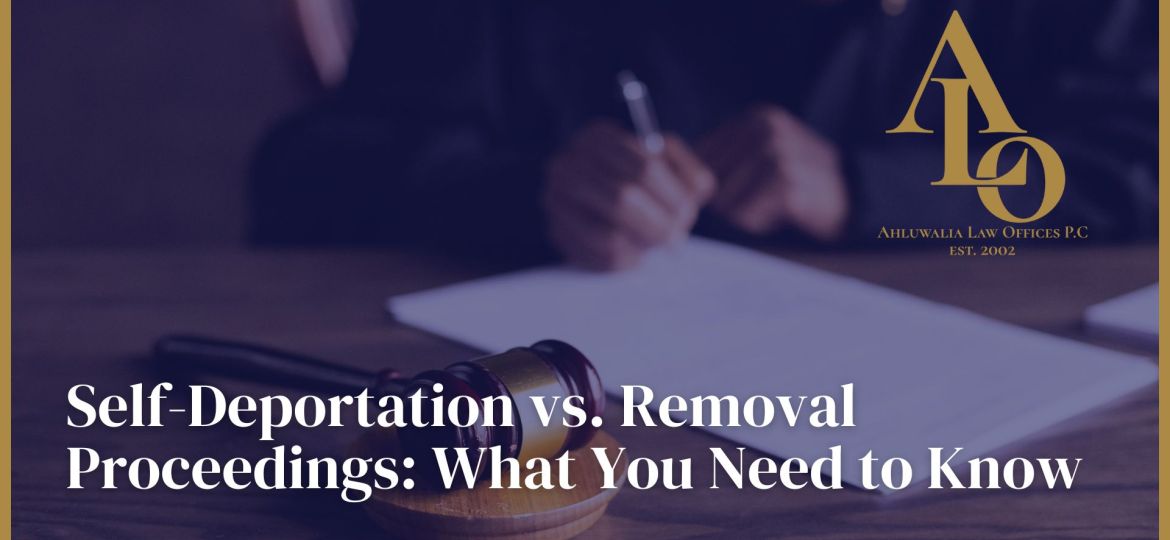
For foreign nationals facing immigration challenges, the choice between self-deportation vs removal can have life-changing consequences. While both involve leaving the United States, the legal implications, future immigration options, and long-term consequences are very different.
At Ahluwalia Law Offices, we believe that understanding these distinctions is critical for anyone navigating immigration enforcement or considering voluntary departure.
What Is Self-Deportation?
The U.S. government sometimes refers to “self-deportation” as voluntary departure. This option allows a noncitizen to leave the country on their own terms before being formally ordered removed.
- Eligibility: Only available to certain individuals, typically before or during removal proceedings, and subject to strict requirements under the Immigration and Nationality Act (INA).
- Process: An individual requests voluntary departure, either from U.S. Immigration and Customs Enforcement (ICE) or the immigration judge (see ICE Self-Removal Guidance).
- Benefits:
- Avoids a formal removal order on record.
- May preserve eligibility for some future immigration benefits.
- Provides a short window of time (usually 60–120 days) to arrange departure.
However, failing to depart by the deadline can result in severe penalties, including a 10-year bar from certain forms of relief.
What Are Removal Proceedings?
Removal proceedings are the formal legal process conducted in Immigration Court by the Executive Office for Immigration Review (EOIR). The Department of Homeland Security (DHS) initiates these proceedings by issuing a Notice to Appear (NTA).
- Process:
- You appear before an immigration judge.
- DHS attorneys present the government’s case.
- You may present defenses, apply for relief (such as asylum or cancellation of removal), or seek adjustment of status. (EOIR Guidance)
- Outcome:
- If successful, you may remain lawfully in the U.S. with an immigration benefit.
- If unsuccessful, the court will issue an official removal order.
A removal order carries serious consequences, including long-term bars to re-entry, potential ineligibility for future visas, and heightened scrutiny at any U.S. consulate or border.
Key Differences: Self-Deportation vs Removal
| Factor | Self-Deportation (Voluntary Departure) | Removal Proceedings |
|---|---|---|
| Control | Individual chooses to depart | Court-ordered process |
| Record | No formal removal order | Formal removal order entered |
| Future Immigration Options | Generally more favorable | Severe restrictions and re-entry bars |
| Timeline | Short, strict deadline to leave | Can take months or years |
| Risk | Penalties if you overstay departure date | Deportation on record if relief denied |
Long-Term Consequences
- Voluntary Departure: If honored properly, it may keep certain immigration options open, such as applying for a visa or waiver in the future.
- Removal Order: Creates significant barriers, including bars to reentry and higher scrutiny of future applications.
Making the Right Decision
The choice between self-deportation vs removal is not simple. Every case depends on individual circumstances—such as criminal history, eligibility for relief, and long-term immigration goals.
Before making a decision, it is essential to consult with an experienced immigration attorney. At Ahluwalia Law Offices, we guide our clients through both voluntary departure requests and removal defense, ensuring that every option is carefully weighed with full awareness of risks and consequences.
If you or a loved one is facing the possibility of removal, contact Ahluwalia Law Offices for a consultation. Our attorneys are dedicated to protecting your rights and helping you make informed decisions about your future.


